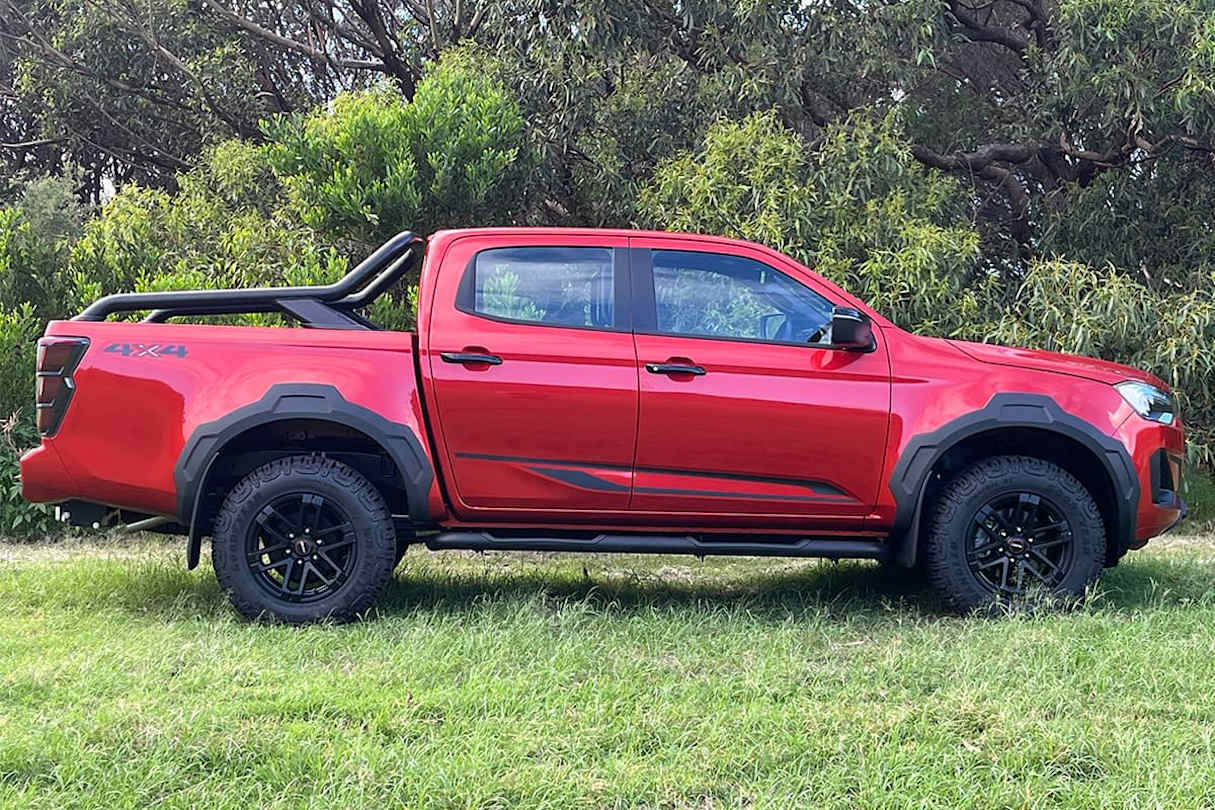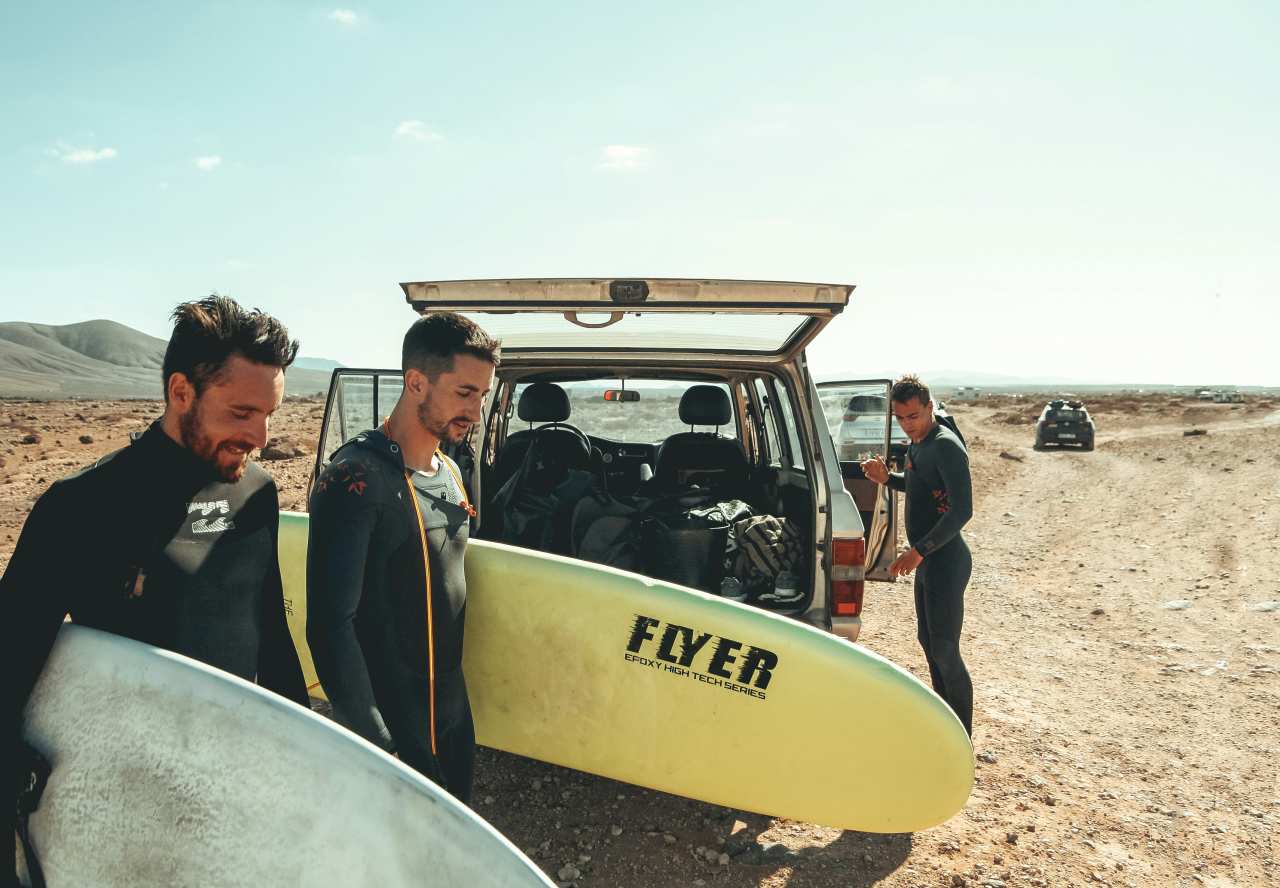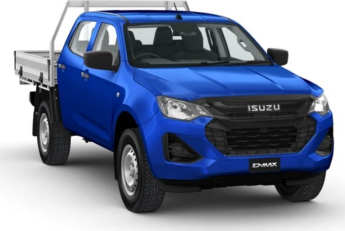Carmakers nowadays are increasingly entering into collaborations with vehicle-engineering companies in order to develop “special” vehicles.
Why?
Well, for one thing, car buyers now demand much more than a mere sticker pack on their 4WD if that vehicle has been marketed as a limited-edition/special-edition/whatever version of the standard vehicle on which it’s based.
And these special vehicles have proven very popular because they benefit from the substantial engineering work undertaken away from the OEM.
You only have to look at the recent collaborations between Nissan Australia and Melbourne-based vehicle engineering company, Premcar, on the Navara and Patrol Warrior to see that Premcar and companies of the same ilk can be entrusted with conversion work, engineering upgrades and the fitment of off-road accessories in order to add real value to a vehicle.
And so it is that Isuzu has joined forces with Walkinshaw Automotive Group to develop the D-Max Blade.
Based on the LS-U+, the Blade was developed locally and among its enhancements over and above the D-Max on which it’s based, it has Aussie-tuned lifted suspension, a lightbar, underbody protection, light truck construction all-terrain tyres and some Blade-specific design enhancements.
But with the same powertrain as a LS-U+ and no power and torque improvements, is the Blade worthy of your consideration?
Read on.
Isuzu D-MAX 2025: Blade
| Engine Type | Diesel Turbo 4, 3.0L |
|---|---|
| Fuel Type | Diesel |
| Fuel Efficiency | 8.0L/100km (combined) |
| Seating | 5 |
| Price From | $78,900 |
| Safety Rating |
|
Price and features – Does it represent good value for the price? What features does it come with? 8/10
8 / 10
The D-Max Blade has a national drive-away price of $76,990 ($78,900 RRP) at the time of writing (early Feb 2025), so it’s now the most expensive D-Max available, costing about $9000 more than the line-up’s former big Kohuna, the X-Terrain.
It’s also about $15,000 more than the mid-range LS-U+ on which it’s based.

Our test vehicle had a few extras onboard including the no-cost option premium paint (Sunstone Orange), a tow bar tongue ($215.05), 12-pin plug ($393.25), and an electronic brake controller ($896.05). Those extras fitted at the time of sale attract stamp duty of $80.85.
Price as tested, according to Isuzu, is $78,687.85.

Standard D-Max features include a 9.0-inch touchscreen multimedia system display (with wired and wireless Apple CarPlay and Android Auto), eight-way power-adjustable driver’s seat, leather-accented upholstery, heated front seats, reversing camera with dynamic guidelines, a rear-diff lock, Rough Terrain mode and more.
Blade extras of substance include lifted suspension (finished in Isuzu red), 3mm-think steel bash plate underbody protection (in Isuzu red), eight-tonne load rated recovery points with cross-bracing, (finished in Isuzu red), and satin black 17x8.5-inch +28 flow-formed alloy wheels with 275/65R17 Goodyear Wrangler Duratrac RT all-terrain tyres.

It also gets a stack of design-related extras which will get a mention in the Design section (below).
Exterior paint choices include 'Moonstone White' pearl, 'Basalt Black' mica, 'Granite Grey' mica or 'Sunstone Orange' mica.
Design – Is there anything interesting about its design? 7/10
7 / 10
The Blade’s distinctive look builds on the D-Max’s most recent refresh treatment, in which the ute received new headlights, a bigger grille, redesigned wheels, and three-tier LED tail-lights.
In terms of dimensions, the Blade is 5308mm long (with a 3125mm wheelbase), 1810mm high and 1910mm wide (excluding wing mirrors).
In comparison, the LS-U+ is 5285mm long (with a 3125mm wheelbase), 1790mm high and 1870mm wide (excluding wing mirrors).

So, the Blade is longer, taller, wider (with wider wheels and wheel tracks, and 23mm-wider wheel-arch flares), beefier and more imposing than its standard stablemates.
Also, at a listed kerb weight of 2204kg, this ute is 89kg heavier than the LS-U+.
Exterior Blade extras (all of these are satin black) include front grille with ‘ISUZU’ lettering (and integrated, tinted 112-watt lightbar), front bumper cladding, fender flares with integrated air curtains, ‘BLADE’ lettering across the tailgate, tailgate badging, decals on the front bar, bonnet, doors and tailgate, tubular sidesteps, and a one-piece extended sports bar with integrated stop lamp.

It also gets widened mud flaps, an individually numbered 'BLADE' identification plaque in engine bay, 'Basalt Black' tailgate and door handles and door mirrors.
Inside there are ‘BLADE’ embroidered head rests, 'BLADE’ embroidered floor mats, 'BLADE’ embossed scuff plates, and an individually numbered 'BLADE' identification plaque on the transmission selector surround.
Everything looks good, except...

This vehicle would be a whole lot more appealing without the cheesy katana-style stickers everywhere and the huge ‘BLADE’ emblazoned on its rear end. The ‘Blade’ mentions on the scuff plates and on the front-seats head-rests are about all the decoration it should have.
The decals are shaped to bring to mind the blades of samurai swords I guess, but they look more like ice hockey sticks to me – and they shouldn’t be there.
This ute would benefit from more of a subtle look – it’s chunkier-than-thou appearance speaks for itself, so there’s no need for garish tarting up of any sort.
Practicality – How practical is its space and tech inside? 8/10
8 / 10
Isuzu could never be accused of ever sacrificing substance for style in the D-Max and that remains true in the Blade.
Not a lot separates the LS-U+ and Blade in terms of functionality or comfort because they share essentially the same interior with only a few differences.
The interior here is at heart a workhorse’s cabin with no fancy-schmancy elements that might spoil this ute’s primary purpose: work … and a fair dose of play, of course.

The latest round of D-Max upgrades brought with it enhanced interior materials, a new 9.0-inch touchscreen multimedia system as well as upgraded functionality across all dash tech, and more charging spots for smart devices.
And the Blade treatment doesn’t add anything other than the aforementioned style tweaks to that – which is fine.
The cabin has a pleasantly familiar feel about it and it’s an easy space in which to swiftly become comfortable and to figure out where all controls are (on-screen and real switches, buttons and dials) and how to use them.

The interior is adequately spacious with nicely supportive seats upfront and a reasonably comfortable bench-style pew for the three people at the rear.
The Blade has leather-accented upholstery, but there are expanses of durable plastic surfaces to cope with real-life mess.

Charging options are numerous – a mix of USB-A, USB-C and 12V upfront, and USB-A for the second row – and storage places include recesses for your everyday carry gear, a suitably deep centre console, as well as dual cupholders upfront and cupholders in the fold-down armrest, and bottle holders in the doors.
Back-row passengers get USB ports, directional air-con vents and shallow under-seat storage.

The tub is 1570mm long (at floor level), 1530mm wide (1122mm between the wheel-arches) and 490mm deep. It is a double-walled tub, with an under-rail tub liner, two cargo tie-down points, and it has tailgate assist.
Tub options for D-Max owners include a tonneau or roller cover (which offers at least some degree of security from thieves, and protection from rain, mud, snow etc), or an Isuzu or aftermarket canopy, although a canopy impacts the versatility of the load space because once it’s an enclosed area it makes it more difficult to carry long, awkward and/or large loads in the tub.
Under the bonnet – What are the key stats for its engine and transmission? 8/10
8 / 10
The D-Max Blade has the D-Max line-up’s 3.0-litre four-cylinder turbo-diesel engine – producing 140kW at 3600rpm and 450Nm from 1600 to 2600rpm – and it’s matched to a six-speed auto.
Just to be clear: the Blade does not have any power or torque advantages over the standard D-Max.

This engine and auto combination form part of a proven powertrain and while this ute is sluggish when accelerating and it’s not the most dynamic vehicle to drive, the D-Max has a real tractability about it that negates most other flaws.
It has part-time 4WD, with high- and low-range. Driver-assist tech, such as rough terrain mode, has been tweaked with the aim of making Isuzu 4WDs perform off-road even better than before.
Efficiency – What is its fuel consumption? What is its driving range? 8/10
8 / 10
Official fuel consumption for this D-Max is 8.0L/100km on a combined cycle.
Actual fuel consumption on this test, from pump to pump, was 10.6L/100km for the D-Max.

The D-Max has a 76-litre fuel tank so, going by those fuel consumption figures, you should be able to get a driving range of about 717km from a full tank.
Driving – What's it like to drive? 8/10
8 / 10
The D-Max has never been a stand-out performer on-road in the ute segment, but it’s never been atrocious either.
The engine and auto combination yield a solid drivability rather than any liveliness, which works fine in this ute package.
Suffice to say, the D-Max is consistently middle of the pack when it comes to ride and handling or refinement comparisons, but again that suits this ute package.
Besides, the D-Max is a body-on-frame ute with leaf spring rear suspension, so it can’t be expected to produce sportscar-like driving qualities, though the most recent upgrades to the D-Max did improve the steering and driver-assist tech.
But then came the Blade project, which wasn’t about improving the ute’s around-town driveability: Isuzu brought in the Walkinshaw Automotive Group, one of Australia’s leading automotive engineering firms, to make a version of the D-Max that was even better at off-roading than the standard unmodified D-Max.

Boiling down thousands of kilometres and man-hours of Walkinshaw’s work on the Blade into the most salient points for this yarn does not accurately reflect the effort of those involved in the years-long process … but here goes anyway: Walkinshaw has designed, engineered and remanufactured some of Australia’s most iconic nameplates, and, while the Blade reworking doesn’t introduce any new mechanical or driver-assist tech set-ups to the D-Max package, the introduction of new all-terrain tyres, wider wheel track and Aussie-tuned suspension (including Monroe 35mm MTV twin-tube dampers with lifted spring seats) has added a welcome measure of composure to this ute’s on-road behaviour.
And Isuzu big wigs must be feeling a bit chuffed at this point in time because Walkinshaw’s off-road mods have produced real results where they count most: off-road.
The standard D-Max in LS-U+ guise is an impressive 4WD ute, but the Blade version is a touch better on a variety of terrain for a number of reasons.
For starters, the Blade’s Walkinshaw-developed suspension set-up, with those 35mm twin-tube dampers in the mix, yields a more agreeable drive, with more comfort and better chassis control than a regular D-Max on fast dirt tracks and corrugated gravel roads. It manages to subdue most of the lumps and bumps you’re bound to drive over on your way to a beach- or bush-camping destination.

The Blade’s wheel track – at 1602mm, 32mm wider than the LS-U+’s 1570mm – gives this ute a slightly more planted posture than its standard stablemate for improved stability and handling.
And while the Blade’s tyres aren’t gung-ho mud-terrains or something similar, its 275/65R17 Goodyear Wrangler Duratrac RT all-terrain tyres do work sufficiently well on-road and off.
For low-range 4WDing, the Blade has all of the D-Max good stuff – including a tractable engine with plenty of low-down torque and a recalibrated off-road traction control (part of the most recent D-Max upgrades) – but its ground clearance (244mm vs the LS-U+’s 240mm) and off-road angles (29.2° approach, 19.2° departure and 25.2° breakover vs the LS-U+’s 30.5°, 19.0°, and 23.8°) don’t represent as much of an improvement over its stablemate as you’d expect in a vehicle touted by Isuzu as “an off-road ute without compromise” and “an unparalleled combination of off-road performance and rugged reliability”.
The Blade feels vulnerable to underbody knocks from rocks and the like, but it has 3mm-thick steel bash plate protection so there’s no need to lose any sleep over a few ‘rubbing dirt’ moments.
Its tubular sidesteps at least seem hardier than the standard D-Max’s sidesteps and seem able to cop knocks from rocks without crumpling.
If there’s any need for a vehicle recovery, the Blade has eight-tonne load-rated recovery points (with bracing between chassis rails for torsional rigidity) to work with.
Also, if you’re thinking about using your Blade as a touring platform, at a listed kerb weight of 2204kg, it is 89kg heavier than the LS-U+, and its payload is 896kg (down form the LS-U+’s 990kg). GVM is 3100kg, GCM is 6000kg.
Towing capacities remain at 750kg (unbraked) and 3500kg (braked).
Warranty & Safety Rating
Safety – What safety equipment is fitted? What is its safety rating? 8/10
8 / 10
The D-Max has the maximum five-star ANCAP safety rating.
As standard, it has auto emergency braking (AEB), eight airbags (dual front, curtain, side, driver's knee and far side) and a comprehensive suite of driver-assist tech including forward collision warning, adaptive cruise control, lane departure warning, a tyre-pressure monitoring system and a raft of other driver-assist tech.
Isuzu's Intelligent Driver Assistance System (IDAS) also includes AEB with turn assist, 'Intelligent' adaptive cruise control, traffic sign recognition, lane departure prevention, lane keeping assist, emergency lane keeping, blind spot monitoring, rear cross-traffic alert, rear cross-traffic brake, digital reversing camera and trailer sway control.
Ownership – What warranty is offered? What are its service intervals? What are its running costs? 8/10
8 / 10
The D-Max has a six-year/150,000km warranty and seven years of roadside assistance when you have your D-Max always serviced at a participating Isuzu ute dealer. That warranty is okay in terms of years, but unlimited kilometres would be a welcome sweetener.
Service intervals are scheduled for every 12 months or 15,000km, whichever occurs soonest.
Capped-price servicing covers the first five scheduled services for 24MY and later vehicle models (up to five years/75,000km - whichever occurs first) – at a flat price of $449 for each service.
Verdict
There’s a lot to like about the regular D-Max in terms of standard features, driver-assist tech, and all-round driveability – it’s an impressive 4WD with plenty of appeal as a daily driver.
And the Blade is even better – but not by a lot.
Walkinshaw’s work on the Blade has bolstered that appeal with conversion work, engineering upgrades and fitment of accessories and all of those elements are the kind of sensible changes an experienced 4WDer would usually make to their own stock-standard vehicle via the aftermarket.
And that’s a crucial point with these type of factory-modded vehicles: some people prefer to do the research, sourcing, purchasing and even the fitment of mods and accessories themselves rather than buy a ready-made adventure machine.
However, there’s no denying the convenience of a factory-backed and -accessorised 4WD ute or wagon, and Isuzu and Walkinshaw have proven, in the same way that Nissan and Premcar have, that these kinds of collaborations can yield positive results.
Do you need a Blade? No, and an LS-U+ might better suit your lifestyle. But do you want a Blade? Many a D-Max fan would say “Yes!” without hesitation.
Pricing Guides















